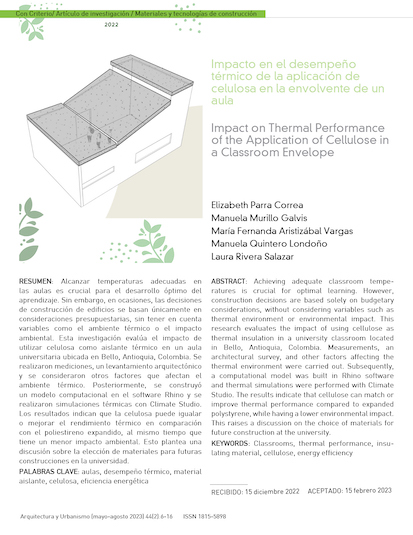Impact on Thermal Performance of The Application of Cellulose in a Classroom Envelope
Keywords:
classrooms, thermal performance, insulating material, cellulose, energy efficiencyAbstract
Achieving adequate classroom temperatures is crucial for optimal learning. However, construction decisions are based solely on budgetary considerations, without considering variables such as thermal environment or environmental impact. This research evaluates the impact of using cellulose as thermal insulation in a university classroom located in Bello, Antioquia, Colombia. Measurements, an architectural survey, and other factors affecting the thermal environment were carried out. Subsequently, a computational model was built in Rhino software and thermal simulations were performed with Climate Studio. The results indicate that cellulose can match or improve thermal performance compared to expanded polystyrene, while having a lower environmental impact. This raises a discussion on the choice of materials for future construction at the university.
References
Montoya Florez OL, Viegas GM. Confort térmico en aulas escolares del trópico, a partir de la aplicación de estrategias de diseño bioclimáticas pasivas. Av en Energías Renov y Medio Ambient [Internet]. 2019 [consultado: 7 de abril de 2022]; 23:[01–55 pp.]. Disponible en: http://sedici.unlp.edu.ar/handle/10915/109499
Ministerio de Educación, Icontec. NTC 4595 Ingeniería Civil y Arquitectura. Planeamiento y Diseño de Instalaciones y Ambientes Escolares Planeamiento y diseño de instalaciones y ambientes escolares. 2015. Disponible en: https://www.mineducacion.gov.co/1759/articles-355996_archivo_pdf_norma_tecnica.pdf
Guevara G, Soriano G, Mino-Rodriguez I. Thermal comfort in university classrooms: An experimental study in the tropics. Build Environ [Internet]. 2021 [consultado: 7 de abril de 2022]; 187(107430). Disponible en: https://doi.org/10.1016/j.buildenv.2020.107430
Vidal T, Torres AL, Valls C, Cusola O, López JA, Fernández J, et al. Potencial de la celulosa en la construcción de nuevos materiales. Jorn Recer EGE-UPC [Internet]. 2019 [consultado: 7 de abril de 2022]. 147–55 pp. Disponible en: http://hdl.handle.net/2117/129131
Cuba Córdoba A, Garzón Bernal LD. Paneles tipo sandwich a base de celulosa reciclada para fachadas [trabajo de grado]. Bogotá: Facultad de Arquitectura, Universidad La Gran Colombia; 2020. Disponible en: https://repository.ugc.edu.co/bitstream/handle/11396/5883/Paneles%20tipo%20sandwich%20a%20base%20de%20celulosa%20reciclada%20para%20fachadas.pdf?sequence=1&isAllowed=y
DEGREN Design & Green Engineering. Guía para la selección de materiales de construcción sostenible. Cáceres: INTROMAC, Instituto Tecnológico de Rocas Ornamentales y Materiales de Construcción; 2019. Disponible en: http://www.degren.eu/wp-content/uploads/2020/05/DEGREN-SMCS.pdf
Palomo M. Aislantes térmicos : criterios de selección por requisitos energéticos [proyecto de fin de carrera]. Madrid: Universidad Politécnica de Madrid; 2017. Disponible en: http://oa.upm.es/47071/1/TFG_Palomo_Cano_Marta.pdf
Madurwar MV, Ralegaonkar RV, Mandavgane SA. Application of agro-waste for sustainable construction materials: A review. Constr Build Mater [Internet]. 2013 [consultado: 7 de abril de 2022]; 38(October):[872–8 pp.]. Disponible en: http://dx.doi.org/10.1016/j.conbuildmat.2012.09.011
Rodríguez Gálvez H. Aislamientos Naturales II: La celulosa [Internet]. Disponible en: http://www.mimbrea.com/aislamientos-naturales-ii-la-celulosa/

Downloads
Published
How to Cite
Issue
Section
License
Copyright (c) 2023 Revista científica de Arquitectura y Urbanismo

This work is licensed under a Creative Commons Attribution-NonCommercial-NoDerivatives 4.0 International License.
a. The authors retain the copyright and guarantee the magazine the right to be the first publication of the work as well as a Creative Commons Attribution License that allows others to share the work with an acknowledgment of the authorship of the work and the initial publication in this magazine.
b. Authors may separately establish additional agreements for the non-exclusive distribution of the version of the work published in the journal (for example, place it in an institutional repository or publish it in a book), with an acknowledgment of its initial publication in this journal.
c. Authors are allowed and encouraged to disseminate their work electronically (for example, in institutional repositories or on their own website) before and during the submission process, as it can lead to productive exchanges, as well as a more early and major published papers (See The Effect of Open Access, in English).

